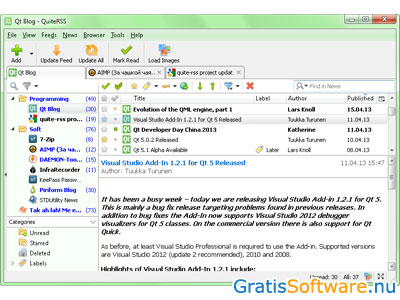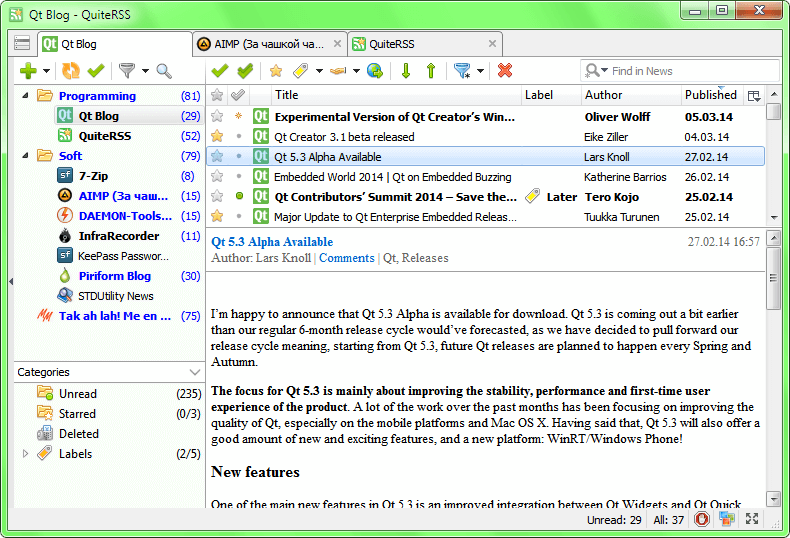
All of these can be configured, and I was able to turn off all notifications. QuiteRSS has support for periodic checking, and there are a number of ways to be notified of available news, including system notifications, an icon in the system tray, and sound. It usually displays the author email address as a link, but in this (invalid feed) case it simply displays the names. I added the feed that Thunderbird refuses to load due to validation issues, and QuiteRSS handles it without any problems.
#AUTOMATICALLY ADD FEED TO QUITERSS PASSWORD#
The username and password can be specified in the feed settings, but the program options includes a password manager, which gives a nice overview of credentials. QuiteRSS has special support for authenticated feeds. This is a really nice feature, as it allows to you turn off image loading only in feeds that load large images! AdBlock is on by default, and JavaScript can be enabled/disabled per feed. While images are displayed by default, there are a lot of great options available! Image loading can be easily toggled using a global setting, but image loading can also be enabled/disabled per feed. This issue was easily fixed by configuring the fonts. In particular, the Japanese was not displayed consistently. The default fonts (on my system) looked pretty bad, as they defaulted to Droid fonts for some reason. Japanese is displayed without issue, tables look good, and images are displayed by default. Other links are made easily accessible, which is great! Podcast enclosures are displayed using a link titled “Link to audio” and URLs can be copied via a right click. Item links can be copied via a right click. I love this feature! (I have to manually switch my focus back to Thunderbird, which is a nuisance.)

When I open an item in my external browser, the focus is automatically switched back to QuiteRSS. I was able to configure it to use my external browser instead in the configuration, however. When displaying an item, clicking on the item title opens the item link in the embedded browser by default. The clean up process can be configured to run when the program is closed, which is enabled by default. Deleted items can be removed manually, or they can be removed as part of the “clean up” process. One can easily limit searching to titles, making it easy to find a deleted item. When items are deleted, they go to a “Deleted” category in the “Categories” pane. The performance of checking all feeds is reasonable. In the case of starting with QuiteRSS, one would configure the folders and feeds appropriately from the beginning.įeed titles default to the those specified in the feeds, but users can set a better name when desired. Note that these are both necessary only because the feeds are imported from my OPML file that was exported from Thunderbird. Those folders are imported into QuiteRSS, so I manually removed them. Nice! Since they are not displayed in Thunderbird, I have to create a folder per feed.

When first running the program, it loads the QuiteRSS feed by default. I bet that QuiteRSS looks fine in a Qt system such as Plasma, but I cannot imagine using such a heavy system again. I like my system to be as lightweight and fast as possible, so I use the i3 window manager with minimal system services. I suspect that this is a problem with my system. When this happens, I have to close the menu and try again until it works.

For example, opening a menu causes the menu to be displayed with a lot of static/lines to the point that it is unreadable. Unfortunately, the user interface often produces many artifacts on my system. I installed the latest version of QuiteRSS using my package manager: $ sudo pacman -S quiterss It is built on the Qt platform (which probably inspired the name) and includes an embedded WebKit browser. QuiteRSS is a GUI RSS client that looks promising.


 0 kommentar(er)
0 kommentar(er)
